Excerpts from Jim Conrad's
Naturalist Newsletter
from the October 6, 2013 Newsletter issued from the Frio Canyon Nature Education Center in the valley of the Dry Frio River in northern Uvalde County, southwestern Texas, on the southern border of the Edwards Plateau; elevation ~1750m (~5750 ft); N29.62°, W99.86°; USA
FLOWERPOT PARASOL MUSHROOM
Except after our rare soaking rains, we seldom see many fleshy fungi. The few who do appear often are hard to impossible to identify because most field guides don't deal with uncommon or semitropical species who might occur here. Therefore, I didn't have much hope for identifying the pale yellowish, two-inch-tall (5cm), fleshy mushroom along one of our hill trails where some time back a fallen tree was chopped up, leaving woodchips on the ground. Below, you can see the little mushroom with numerous narrow, shallow grooves radiating from a distinct, bruised-looking bulge at the cap's very top, and the rest of the cap covered with easily detached, mealy scales:
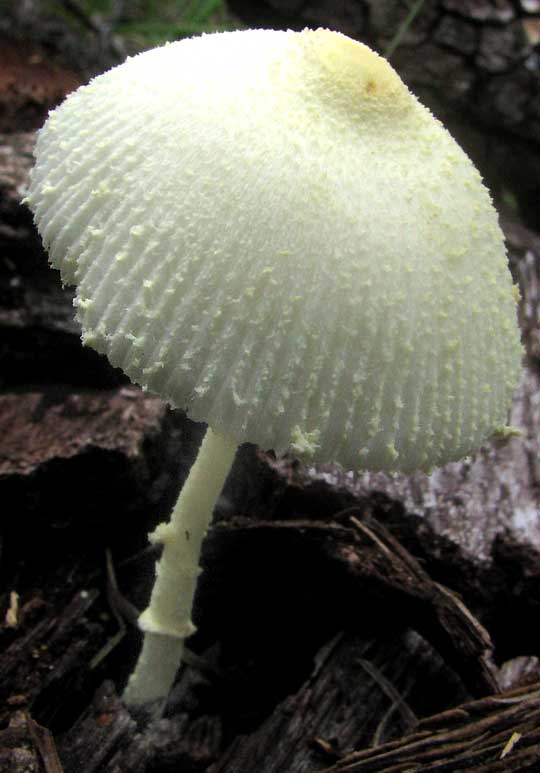
Seeing the stem's collar-like ring, or annulus, I thought the stem might arise from a cuplike volva, like several common and poisonous amanita mushrooms. However, there was no volva. The stem seemed to form where masses of fuzzy, white hyphae merged just below the leaf litter, as shown below:
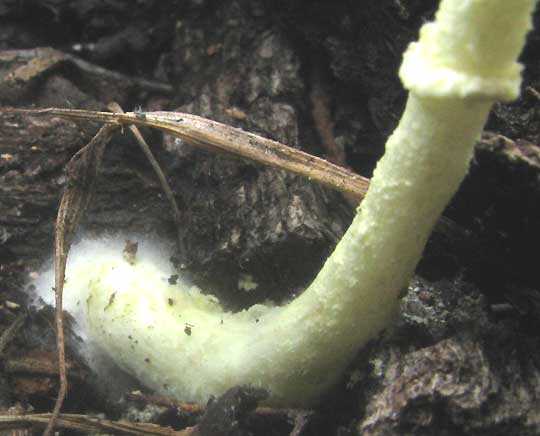
It's a gilled mushroom, and the gills are particularly fine and close together, as shown below:
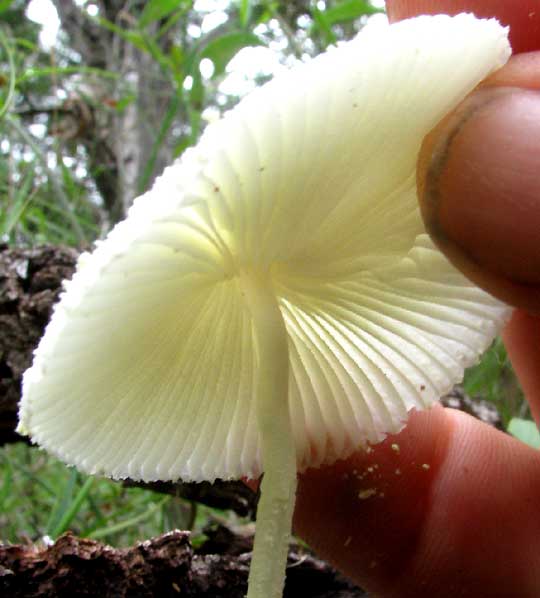
It turned out that our mushroom was easy to identify, the ease explained by the fungus's most commonly used names: Flowerpot Parasol, Plantpot Dapperling and Yellow Houseplant Mushroom. In the Temperate Zone where folks have potted plants sitting around, including in their homes, this little mushroom very often makes an appearance in the potting soil, and people photograph it, and talk about it on the Internet.
It's LEUCOCOPRINUS BIRNBAUMII, common throughout the Earth's tropics and subtropics, and extending here and there into warmer parts of the Temperate Zones, even being recorded as far north as England. In North America and Europe, however, it's more likely to be found in hothouses and plant pots.
The Flowerpot Parasol lives on decaying humus or compost, so it's "saprotrophic." Often it turns up among woodchips surrounding landscape plantings in towns, as in parking lots.
Flowerpot Parasols are perfectly harmless growing in flowerpots, but they shouldn't be eaten, since there are conflicting reports about their toxicity, with some evidence that it can cause stomach problems in a certain percentage of people.
from the November 5, 2017 Newsletter issued from Rancho Regensis north of Valladolid, Yucatán, MÉXICO
FLOWERPOT PARASOLS IN THE YUCATAN
Several days after it stopped raining, still the garden's chest-high thicket of weeds was drenching wet, and the soil sodden. As I macheted my way to the back corner, a clump of small, sulfur-yellow mushrooms caught my eye, growing in cathedral-like darkness beneath a low canopy of tall grass knocked over by the rains. Below, you can see the mushrooms, with a cherry tomato in the picture's lower, left:
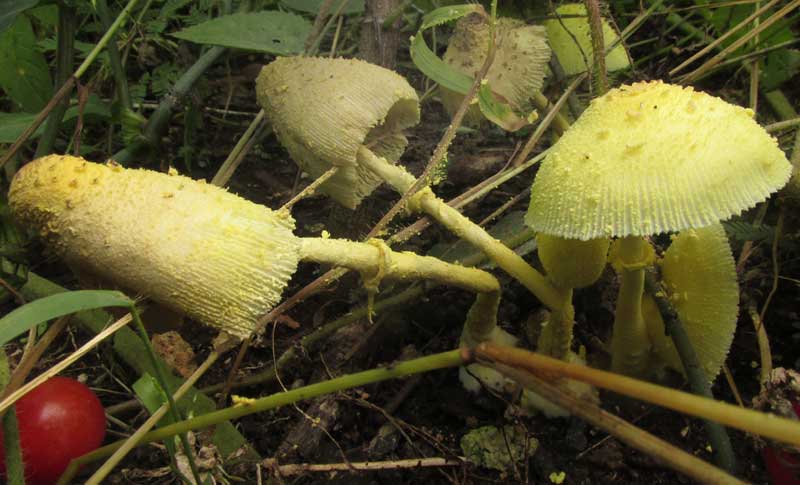
This mushroom displays so many unusual features that I felt confident it might be identifiable, even though the Yucatan is too arid to be good mushroom territory, and relatively few studies have been conducted of the fungi found here.
Important field marks include the mushrooms' bright yellow color, and the fact that they grow in tufts instead of individually -- they're "cespitose". The caps are narrower than usual, are finely striated, and covered with what appear to be yellow crumbs. Closer up, more distinctive features show up, as seen below:
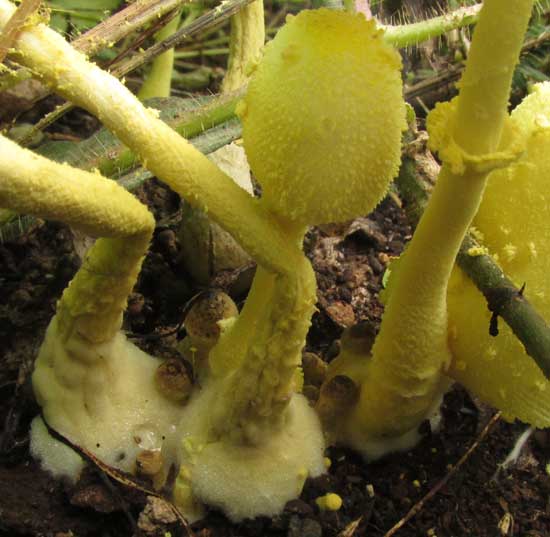
Of most interest diagnostically is the definite ring or "annulus," looking like a yellow collar around the stem at the right. Stems on most mushroom species don't bear such rings. Also notice how the stems expand at their bases. When this mushroom's cap is removed, the spore-producing gills on the cap's underside are very thin and close together, as shown below:
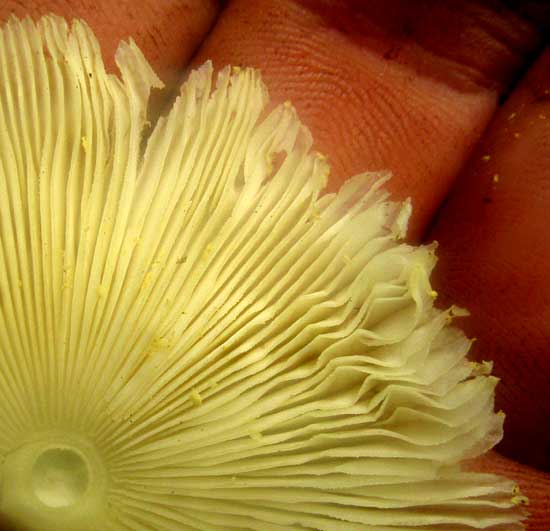
Spores had fallen from the gills in abundance, often ending up clumped on nearby weed-stem hairs, as seen below:
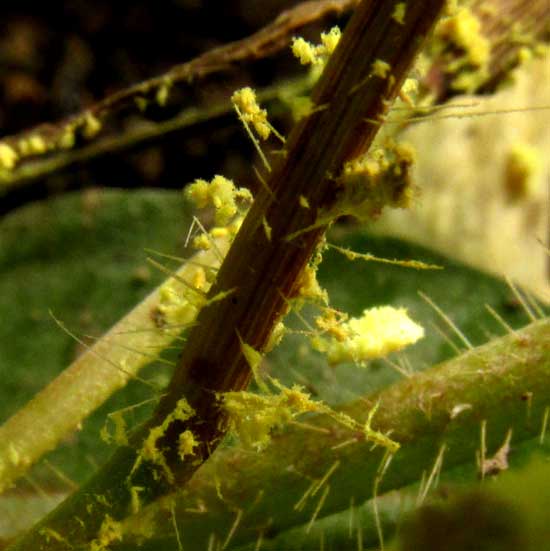
We've seen this species before, up in Texas {previous section}, but it had been very pale yellow, almost white, so at first I didn't make the connection between our yellow garden mushrooms in the Yucatan and the Texas one. Now I read that younger individuals of Leucocoprinus birnbaumii are yellow, and fade toward very pale yellow as they age.
This species goes by several English names, but the one we used in Texas was Flowerpot Parasol, because in North America mostly it's observed in people's flowerpots and greenhouses, though in the world's tropics and subtropics it occurs in the wild. Other popular English names include Yellow Parasol, Lemon-yellow Lepiota and Yellow Pleated Parasol.
Though the clumps of what I assume to be pollen on weed-stem hairs were definitely yellow, the literature states that the spores of Leucocoprinus birnbaumii are white. The mushroom's yellow color is from alkaloids known as birnbaumins. It's unclear whether these birnbaumins are responsible for the stomach problems that some people experience when they eat this species.
Two days after I'd parted the weeds enough to let a little light in for taking the above photos, the mushrooms had withered onto the ground. The mushrooms needed the high humidity in which I'd found them, but those cherry tomatoes had undergone a spurt of new growth,